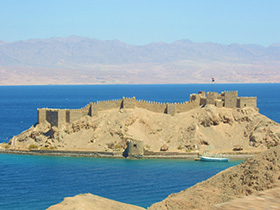Islamic Period and Modern Times Monuments
- Neolithic Period: 4500-3000 BCE
- Early Dynastic: 3000-2650 BCE
- Old Kingdom: 2650-2150 BCE
- 1st Intermediate Period: 2150-2040 BCE
- Middle Kingdom: 2040-1640 BCE
- 2nd Intermediate Period: 1640-1550 BCE
- New Kingdom: 1550-1070 BCE
- 3rd Intermediate Period: 1070-712 BCE
- Saite and Late Periods: 712-332 BCE
- Greco-Roman Period: 332 BCE-642 CE
- Coptic Period: 395-642 CE
- Islamic Period and Modern Times: 642 CE-Today
- Neolithic Period: 4500-3000 BCE
- Early Dynastic: 3000-2650 BCE
- Old Kingdom: 2650-2150 BCE
- 1st Intermediate Period: 2150-2040 BCE
- Middle Kingdom: 2040-1640 BCE
- 2nd Intermediate Period: 1640-1550 BCE
- New Kingdom: 1550-1070 BCE
- 3rd Intermediate Period: 1070-712 BCE
- Saite and Late Periods: 712-332 BCE
- Greco-Roman Period: 332 BCE-642 CE
- Coptic Period: 395-642 CE
- Islamic Period and Modern Times: 642 CE-Today
Saladin Citadel on Pharaoh’s Island
Begun ca. 1116
Although the site contains remnants of Byzantine-era buildings, Crusaders are believed to have built the original fort on this island in the Gulf of Aqaba in the early twelfth century during the reign of Baldwin I, King of Jerusalem, to aid in their control of one of the major routes between Cairo and Damascus. The Arab general and Islamic dynasty founder Saladin conquered the island and surrounding area in 1170-1171.
Saladin ordered the Crusader fort to be consolidated and redeveloped. For about 150 years, it served an important strategic and symbolic role, until the nearby Crusades ended and the Mamluk governor of Aqaba moved his residence to the city on the shore.
From the top of the citadel today, it is possible to see the countries of Egypt, Jordan, Israel, and Saudi Arabia.

https://www.history.com/topics/saladin
http://whc.unesco.org/en/tentativelists/1828/

